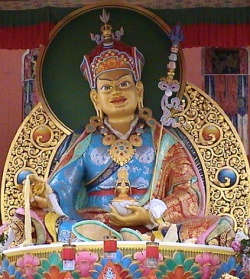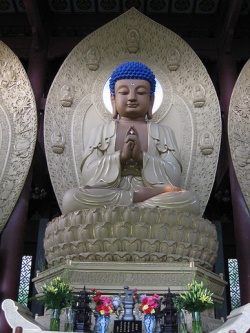Root Guru
The 'Root Guru' is the individual from whom one has received a major anuttarayoga empowerment containing all four sections.
In many Vajrayana practices we visualize our guide, the guru, above or on top of the crown of our head. This is the root guru (Tib. tseway lama,) who symbolizes and embodies all buddhas and bodhisattvas, and holds and imparts the blessings of the lineage. Root Guru The principal Spiritual Guide from whom we have received the empowerments, instructions, and oral transmissions of our main practice.
Sometimes people are uncertain as to which person that should be: "When someone receives an initiation from a master other than our own teacher, who is supposed to be imagined in that position; the Lama on the throne, my teacher, the lineage head? What about great teachers now deceased? What if I am connected to two lineages?"
"Root guru" is the term for the one that is the source of the practice for you. It is the person who has given you the oral instructions on the true nature of mind -- he or she is in the role of the Buddha -- because there is no teaching more important than that. It prepares the ground for enlightenment and sets the stage for opening your heart towards helping others in that way.
Before you meditate, you visualize your root guru, and considering that his lineage is also yours, then the lineage blessings come via him or her.
If you are receiving an empowerment from a member of some other lineage, at that moment, and in that tradition, he is your root guru. Receiving an initiation does not necessarily mean that you are going to do the practice later on at home, but if you are, then you will have to make some choices, which is one of the reasons not to be "promiscuous" in taking part in empowerments in too many different lineages.
When you take a highest tantric initiation such as Chakrasamvara, your root guru will certainly be one who has given it. We will have to do as Lord Marpa and "rank" our teachers for he said, "I have one hundred and eight gurus, thirteen very important gurus, and I have only two most excellent gurus – Naropa and Maitripa."
On the other hand, Milarepa did not have many teachers; for him it was completely clear that Marpa was his tseway lama.
However, if you feel that you cannot choose that you can visualize Guru Rinpoche or Vajradhara as the embodiment of all gurus.
When we visualize the root guru, we see him in our mind's eye the way he actually. However at the same time, we think that he or she is the embodiment of all the others from whom you have received empowerments. As a representative of Guru Rinpoche, Buddha Shakyamuni or Vajradhara, he is also the expression of the Dharmakaya and ultimately, Emptiness.
The thing is, we need to make these choices before the practice so that we can experience the blessing that comes from confidence in the Guru and is related also, to our devotion.
The situation can get complicated: In The Life of Marpa the Translator by Trungpa Rinpoche (79):
. . . then Maitripa advised Marpa, "Go to your teacher Jetsun Santibhadra, who is both Naropa's master and disciple, and supplicate with him for a month."
We can only assume that the role of master and of disciple depends on what practice(s) Naropa and his teacher were doing. Sometimes one could be the guru and the other the chela, and then the roles could change.

